Abstract
Proteoglycans were extracted from bovine (15-18 months old) femoral-head cartilage. The heterogeneity of the A1D1 proteoglycan fraction was examined by gel chromatography, sedimentation velocity, sucrose rate-zonal centrifugation and CS2SO4 isopycnic centrifugation. In all cases polydisperse but unimodal distributions were obtained. Chemical analysis of the preparation yielded a galactosamine/glucosamine molar ratio of 7:1, and 13C n.m.r. spectroscopy showed that the chondroitin sulphate comprised equal proportions of the 4- and 6-sulphate isomers. Gel chromatography of a papain and Pronase digest of the proteoglycan indicated that the chondroitin sulphate chains had a Mn of approx. 10500. The mean buoyant density of the proteoglycan in pure CS2SO4 was 1.46 g/ml. Physical characterization of the proteoglycan preparation in 4M-guanidine hydrochloride, pH 7.4, by using conventional light-scattering gave a radius of gyration of 42 nm and a Mw of 0.96 X 10(6). Quasi-elastic light-scattering in the same solvent yielded a translational diffusion coefficient, D020, of 5.41 X 10(-8) cm2 X S-1, and ultracentrifugation gave a sedimentation coefficient, S020, of 12.0S. Thus from sedimentation-diffusion studies a Mw of 1.36 X 10(6) was calculated. The possible origins for the differences in the two molecular-weight estimates are discussed. It is concluded that the high-buoyant-density proteoglycans from bovine articular cartilage are significantly smaller than those from bovine nasal septum, and that this is largely due to the smaller size of their chondroitin sulphate chains.
Full text
PDF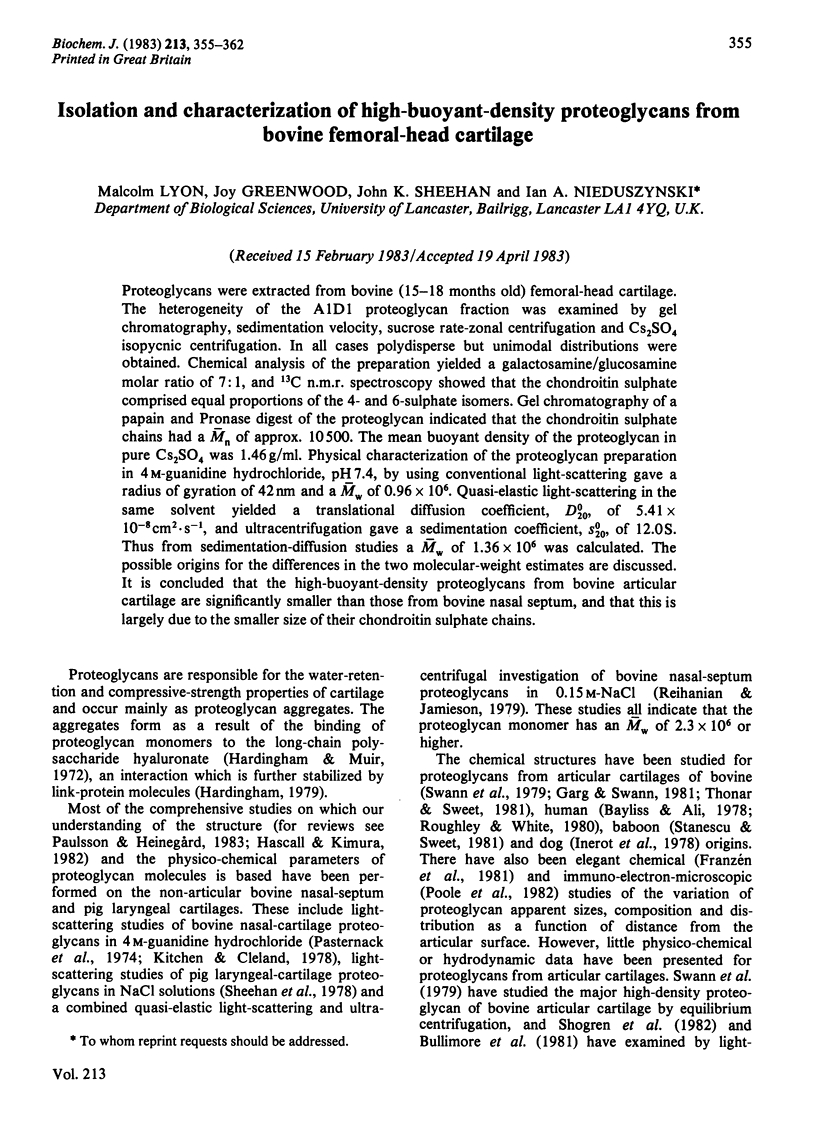
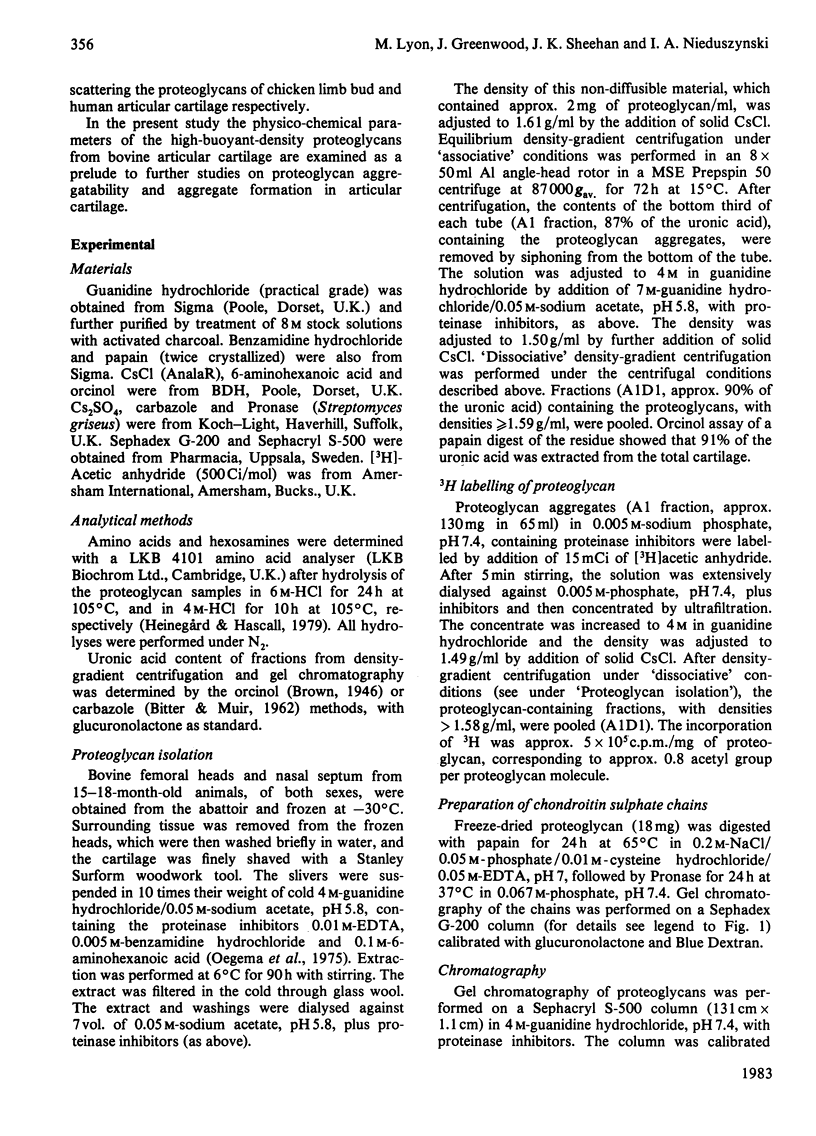
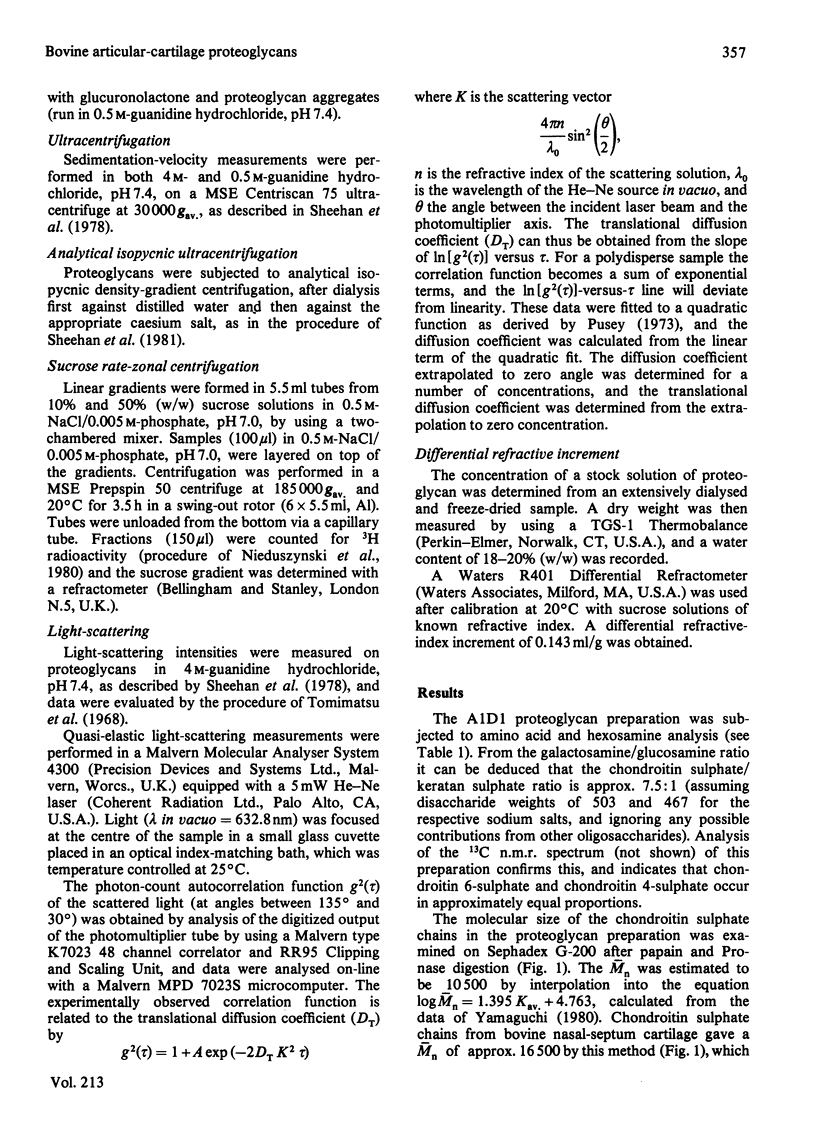
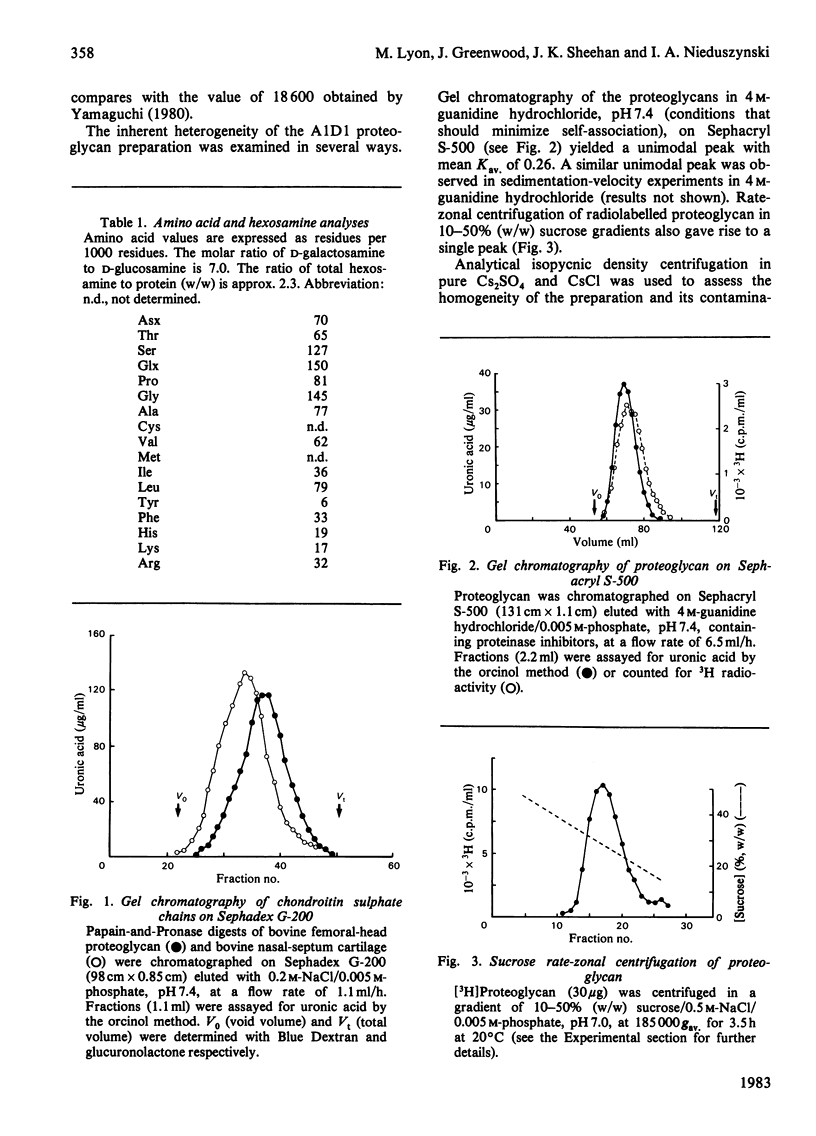
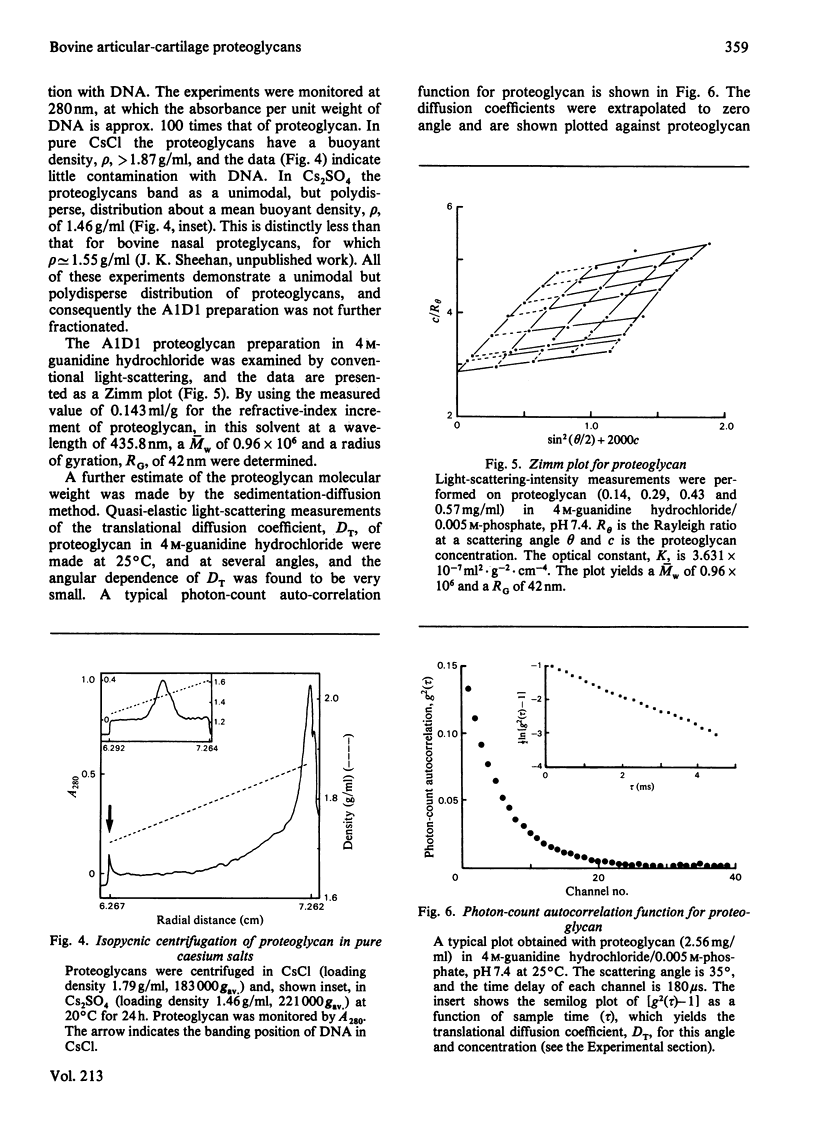
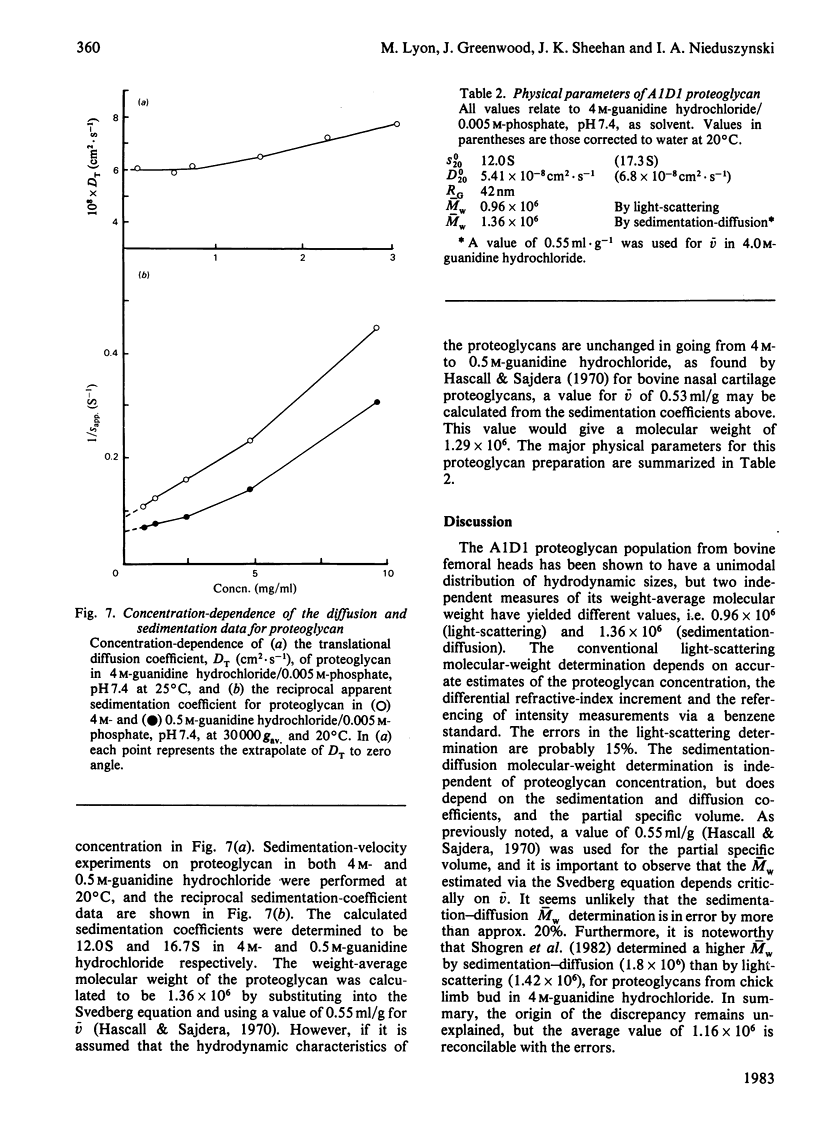
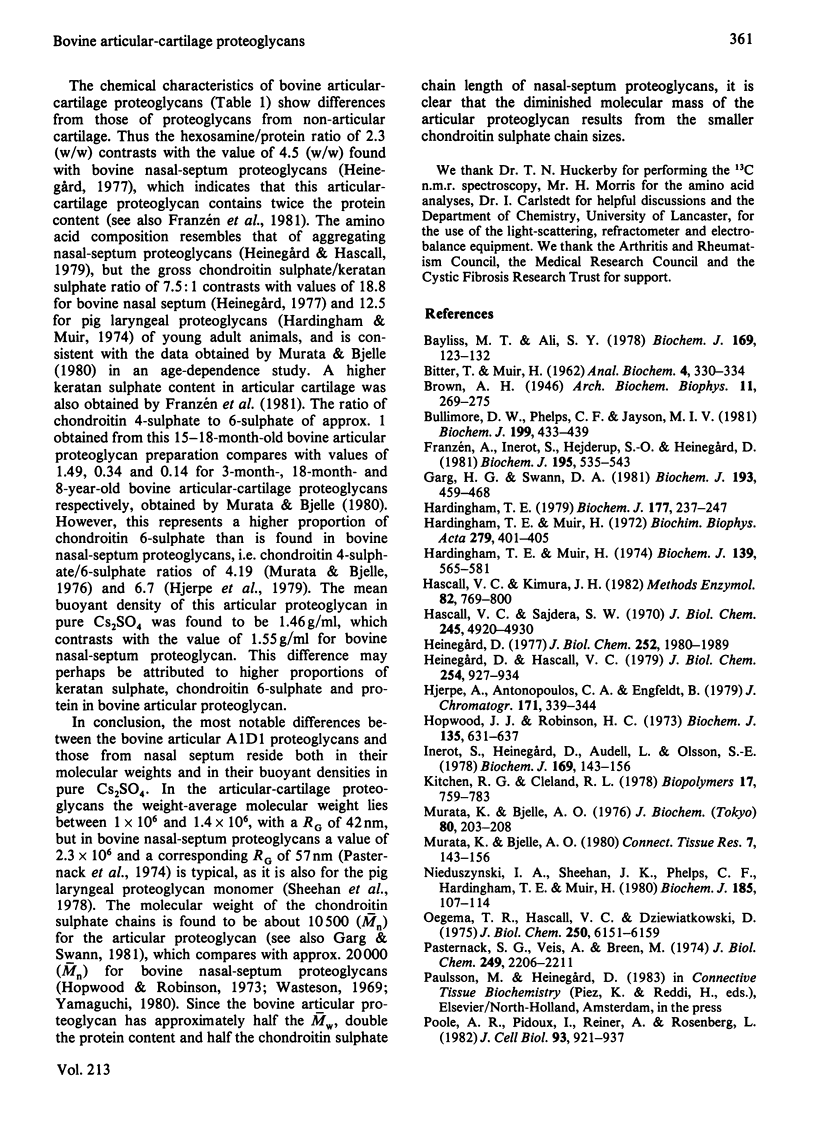
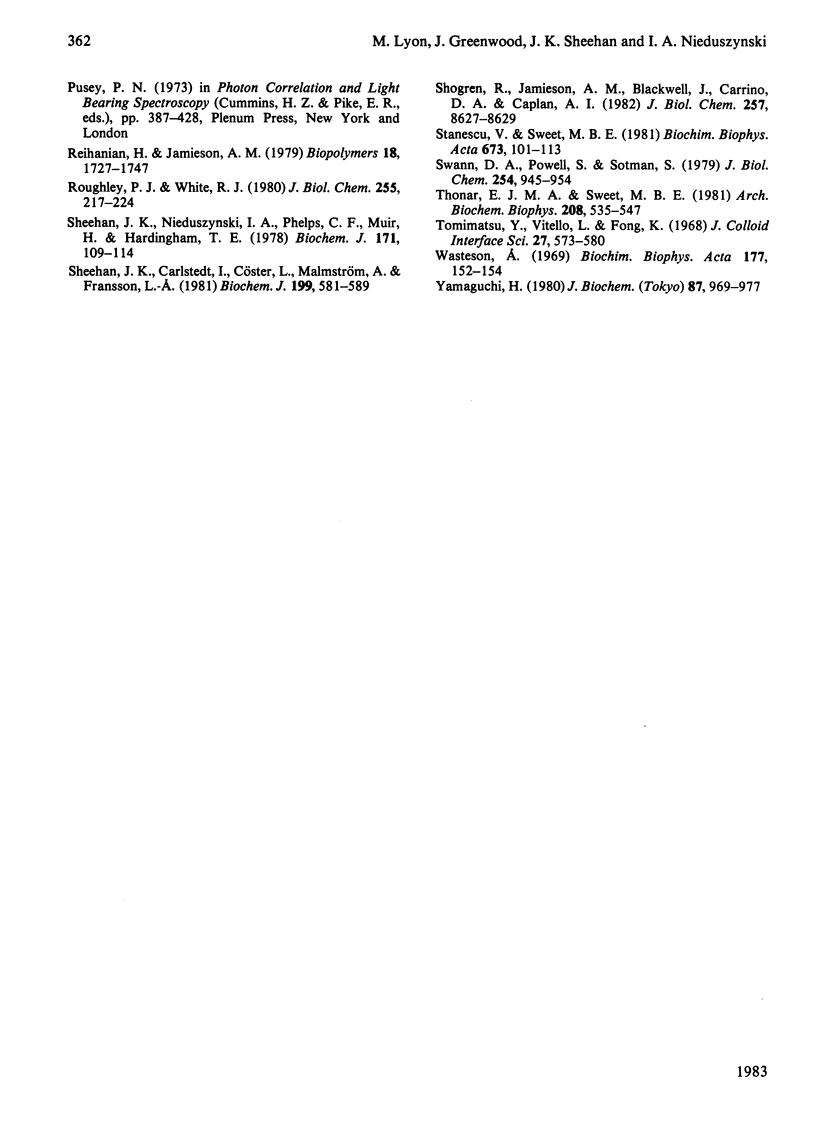
Selected References
These references are in PubMed. This may not be the complete list of references from this article.
- BITTER T., MUIR H. M. A modified uronic acid carbazole reaction. Anal Biochem. 1962 Oct;4:330–334. doi: 10.1016/0003-2697(62)90095-7. [DOI] [PubMed] [Google Scholar]
- Bayliss M. T., Ali S. Y. Isolation of proteoglycans from human articular cartilage. Biochem J. 1978 Jan 1;169(1):123–132. doi: 10.1042/bj1690123. [DOI] [PMC free article] [PubMed] [Google Scholar]
- Bullimore D. W., Phelps C. F., Jayson M. I. Extractable proteoglycan from human femoral-head articular cartilage. Biochem J. 1981 Nov 1;199(2):433–439. doi: 10.1042/bj1990433. [DOI] [PMC free article] [PubMed] [Google Scholar]
- Franzén A., Inerot S., Hejderup S. O., Heinegård D. Variations in the composition of bovine hip articular cartilage with distance from the articular surface. Biochem J. 1981 Jun 1;195(3):535–543. doi: 10.1042/bj1950535. [DOI] [PMC free article] [PubMed] [Google Scholar]
- Garg H. G., Swann D. A. Age-related changes in the chemical composition of bovine articular cartilage. The structure of high-density proteoglycans. Biochem J. 1981 Feb 1;193(2):459–468. doi: 10.1042/bj1930459. [DOI] [PMC free article] [PubMed] [Google Scholar]
- Hardingham T. E., Muir H. Hyaluronic acid in cartilage and proteoglycan aggregation. Biochem J. 1974 Jun;139(3):565–581. doi: 10.1042/bj1390565. [DOI] [PMC free article] [PubMed] [Google Scholar]
- Hardingham T. E., Muir H. The specific interaction of hyaluronic acid with cartillage proteoglycans. Biochim Biophys Acta. 1972 Sep 15;279(2):401–405. doi: 10.1016/0304-4165(72)90160-2. [DOI] [PubMed] [Google Scholar]
- Hardingham T. E. The role of link-protein in the structure of cartilage proteoglycan aggregates. Biochem J. 1979 Jan 1;177(1):237–247. doi: 10.1042/bj1770237. [DOI] [PMC free article] [PubMed] [Google Scholar]
- Hascall V. C., Kimura J. H. Proteoglycans: isolation and characterization. Methods Enzymol. 1982;82(Pt A):769–800. doi: 10.1016/0076-6879(82)82102-2. [DOI] [PubMed] [Google Scholar]
- Hascall V. C., Sajdera S. W. Physical properties and polydispersity of proteoglycan from bovine nasal cartilage. J Biol Chem. 1970 Oct 10;245(19):4920–4930. [PubMed] [Google Scholar]
- Heinegård D. K., Hascall V. C. Characteristics of the nonaggregating proteoglycans isolated from bovine nasal cartilage. J Biol Chem. 1979 Feb 10;254(3):927–934. [PubMed] [Google Scholar]
- Heinegård D. Polydispersity of cartilage proteoglycans. Structural variations with size and buoyant density of the molecules. J Biol Chem. 1977 Mar 25;252(6):1980–1989. [PubMed] [Google Scholar]
- Hjerpe A., Antonopoulos C. A., Engfeldt B. Determination of sulphated disaccharides from chondroitin sulphates by high-performance liquid chromatography. J Chromatogr. 1979 Apr 1;171:339–344. doi: 10.1016/s0021-9673(01)95313-0. [DOI] [PubMed] [Google Scholar]
- Hopwood J. J., Robinson H. C. The molecular-weight distribution of glycosaminoglycans. Biochem J. 1973 Dec;135(4):631–637. doi: 10.1042/bj1350631. [DOI] [PMC free article] [PubMed] [Google Scholar]
- Inerot S., Heinegård D., Audell L., Olsson S. E. Articular-cartilage proteoglycans in aging and osteoarthritis. Biochem J. 1978 Jan 1;169(1):143–156. doi: 10.1042/bj1690143. [DOI] [PMC free article] [PubMed] [Google Scholar]
- Kitchen R. G., Cleland R. L. Dilute solution properties of proteoglycan fractions from bovine nasal cartilage. Biopolymers. 1978 Mar;17(3):759–783. doi: 10.1002/bip.1978.360170316. [DOI] [PubMed] [Google Scholar]
- Murata K., Bjelle A. O. Constitutional variations of acidic glycosaminoglycans in normal and arthritic bovine articular cartilage proteoglycans at different ages. Connect Tissue Res. 1980;7(3):143–156. doi: 10.3109/03008208009152106. [DOI] [PubMed] [Google Scholar]
- Murata K., Bjelle A. O. Distribution of chondroitin sulfate in cartilage proteoglycans under associative conditions. J Biochem. 1976 Aug;80(2):203–208. doi: 10.1093/oxfordjournals.jbchem.a131265. [DOI] [PubMed] [Google Scholar]
- Nieduszynski I. A., Sheehan J. K., Phelps C. F., Hardingham T. E., Muir H. Equilibrium-binding studies of pig laryngeal cartilage proteoglycans with hyaluronate oligosaccharide fractions. Biochem J. 1980 Jan 1;185(1):107–114. doi: 10.1042/bj1850107. [DOI] [PMC free article] [PubMed] [Google Scholar]
- Oegema T. R., Jr, Hascall V. C., Dziewiatkowski D. D. Isolation and characterization of proteoglycans from the swarm rat chondrosarcoma. J Biol Chem. 1975 Aug 10;250(15):6151–6159. [PubMed] [Google Scholar]
- Pasternack S. G., Veis A., Breen M. Solvent-dependent changes in proteoglycan subunit conformation in aqueous guanidine hydrochloride solutions. J Biol Chem. 1974 Apr 10;249(7):2206–2211. [PubMed] [Google Scholar]
- Poole A. R., Pidoux I., Reiner A., Rosenberg L. An immunoelectron microscope study of the organization of proteoglycan monomer, link protein, and collagen in the matrix of articular cartilage. J Cell Biol. 1982 Jun;93(3):921–937. doi: 10.1083/jcb.93.3.921. [DOI] [PMC free article] [PubMed] [Google Scholar]
- Reihanian H., Jamieson A. M., Tang L. H., Rosenberg L. Hydrodynamic properties of proteoglycan subunit from bovine nasal cartilage. Self-association behavior and interaction with hyaluronate studied by laser light scattering. Biopolymers. 1979 Jul;18(7):1727–1747. doi: 10.1002/bip.1979.360180711. [DOI] [PubMed] [Google Scholar]
- Roughley P. J., White R. J. Age-related changes in the structure of the proteoglycan subunits from human articular cartilage. J Biol Chem. 1980 Jan 10;255(1):217–224. [PubMed] [Google Scholar]
- Sheehan J. K., Carlstedt I., Cöster L., Malmström A., Fransson L. A. Isopycnic-centrifugation studies in caesium chloride and in caesium sulphate on dermatan sulphate proteoglycans from bovine sclera. Biochem J. 1981 Dec 1;199(3):581–589. doi: 10.1042/bj1990581. [DOI] [PMC free article] [PubMed] [Google Scholar]
- Sheehan J. K., Nieduszynski I. A., Phelps C. F. Self-association of proteoglycan subunits from pig laryngeal cartilage. Biochem J. 1978 Apr 1;171(1):109–114. doi: 10.1042/bj1710109. [DOI] [PMC free article] [PubMed] [Google Scholar]
- Shogren R., Jamieson A. M., Blackwell J., Carrino D. A., Caplan A. I. Light scattering studies of chick limb bud proteoglycans. J Biol Chem. 1982 Aug 10;257(15):8627–8629. [PubMed] [Google Scholar]
- Stanescu V., Sweet M. B. Characterization of a proteoglycan of high electrophoretic mobility. Biochim Biophys Acta. 1981 Feb 18;673(1):101–113. [PubMed] [Google Scholar]
- Swann D. A., Powell S., Sotman S. The heterogeneity of cartilage proteoglycans. Isolation of different types of proteoglycans from bovine articular cartilage. J Biol Chem. 1979 Feb 10;254(3):945–954. [PubMed] [Google Scholar]
- Thonar E. J., Sweet M. B. Maturation-related changes in proteoglycans of fetal articular cartilage. Arch Biochem Biophys. 1981 May;208(2):535–547. doi: 10.1016/0003-9861(81)90542-7. [DOI] [PubMed] [Google Scholar]
- Wasteson A. A method for the determination of molecular weight dispersion in chondroitin sulphate on a microgram level. Biochim Biophys Acta. 1969 Feb 18;177(1):152–154. doi: 10.1016/0304-4165(69)90076-2. [DOI] [PubMed] [Google Scholar]
- Yamaguchi H. The molecular weight distribution of the chondroitin sulfates of bovine and whale nasal septum. J Biochem. 1980 Mar;87(3):969–977. doi: 10.1093/oxfordjournals.jbchem.a132827. [DOI] [PubMed] [Google Scholar]


